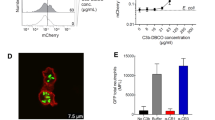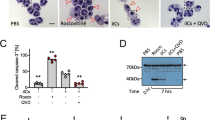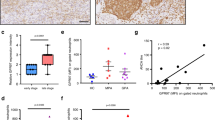Abstract
Human phagocytic cells express receptors for the constant (Fc) region of immunoglobulin G. Neutrophils carry Fc receptor II (FcRII; CDw32) and FcRIII (CD16)1–3 which both bind IgG-containing immune complexes, leading to phagocytosis of the complex and activation of the neutrophil4,5. We find that patients with paroxysmal nocturnal haemoglobinuria (PNH) have only about 10% of the normal levels of FcRIII on their neutrophils, whereas the expression of FcRII is unaffected. We show that FcRIII is a phosphatidyl inositol (Pl)-anchored protein in neutrophils. Analysis of FcRIII expression in cells of PNH patients, known to be deficient in Pi-linked proteins, suggests FcRIII is not Pi-linked in monocytes. We find that the synthesis of FcRIII in neutrophils from PNH patients appears normal, indicating that the defect lies in the PI linkage. This lipid linkage of the receptor on neutrophils suggests that its release may be important for its function, and indeed FcRIII release was observed on stimulation of neutrophils by an inflammatory bacterial peptide (f-Met-Leu-Phe), suggesting a role for FcRIII shedding in inflammatory reactions. Activation of the PNH neutrophils with IgG-coated latex beads appeared normal (although binding of dimer IgG complexes was reduced), indicating that FcRII, rather than FcRIII, is involved in neutrophil stimulation.
This is a preview of subscription content, access via your institution
Access options
Subscribe to this journal
Receive 51 print issues and online access
$199.00 per year
only $3.90 per issue
Buy this article
- Purchase on Springer Link
- Instant access to full article PDF
Prices may be subject to local taxes which are calculated during checkout
Similar content being viewed by others
References
Huizinga, T. W. J. et al. J. Immun. (submitted).
Looney, R. J. et al. J. exp. Med. 163, 826–836 (1986).
Werner, G. et al. Leucocyte Typing II Vol. 3 (eds Reinherz, P. C., Reinherz, E. L., Haynes, B. F., Nadler, L. M. & Bernstein, I. D.) 109–121 (Springer-Verlag, New York, 1985).
Klebanoff, S. J. in Advances in Host Defence Mechanism Vol. 1 (eds Gallin, J. L. & Fauci, A. S.) 111–162 (Raven Press, New York, 1982).
Henson, P. M., Johnson, H. B. & Spiegelberg, H. L. J. Immun. 109, 1182–1192 (1972).
Selvaraj, P., Dustin, M. L., Silber, R., Low, M. G. & Springer, T. A. J. exp. Med. 166, 1011–1025 (1987).
Haziot, A., Low, M. G. & Goyert, S. M. Blood 70 (suppl.), 93 (1987).
Low, M. G., Fluterman, A. H., Ferguson, M. A. J. & Silman, I. Trends biochem. Sci. 11, 212–215 (1986).
Tetteroo, P. A. T., Bos, M. J. E., Visser, F. J. & von dem Borne, A. E. G. Kr. J. Immun. 136, 3427–2432 (1986).
Clarkson, S. B. & Ory, P. A. J. exp. Med. 167, 408–417 (1988).
Noda, M., Yoon, K., Rodan, G. A. & Koppel, D. E. J. Cell Biol. 105, 1671–1677 (1987).
Low, M. G. & Saltiel, A. R. Science 239, 268–274 (1988).
Kay, N. E. & Douglas, S. D. Int. Archs. Allergy appl. Immun. 66, 131–135 (1981).
Molenaar, J. L., van Galen, M., Hannema, A. J., Zeijlemaker, W. P. & Pondman, K. W. Eur. J. Immun. 7, 230–236 (1977).
Papamichail, M., Tsokos, G. & Paraskevas, F. Immunology 40, 47–52 (1980).
Fridman, W. H., Rabourdin-Combe, C., Neuport-Sautes, C. & Gisler, R. H. Immun. Rev. 56, 51–88 (1981).
Limb, G. A., Brown, K. A., Wolstencroft, R. A. & Dumonde, D. C. Clin. exp. Immun. 71, 362–367 (1987).
Simmons, D. & Seed, B. Nature 333, 568–570 (1988).
Tetteroo, P. A. T., van der Schoot, C. E., Visser, F. J., Bos, M. J. E. & von dem Borne, A. E. G. Kr. in Leucocyte Typing III. While Cell Differentiation Antigens (eds McMichael, A. J. et al.) 702–706 (Oxford University Press, Oxford, 1987).
van der Schoot, C. E., Visser, F. J., Bos, M. J. E., Tetteroo, P. A. T. & von dem Borne, A. E. G. Kr. in Leucocyte Typing III. White Cell Differentiation Antigens (eds McMichael, A. J. et al.) 603–611 (Oxford University Press, Oxford, 1987).
Tokuyasu, K. T. J. Microscopy 143, 139–149 (1986).
Slot, J. W. & Geuze, H. J. Eur. J. Cell Biol. 38, 87–93 (1985).
Author information
Authors and Affiliations
Rights and permissions
About this article
Cite this article
Huizinga, T., van der Schoot, C., Jost, C. et al. The Pi-linked receptor FcRIII is released on stimulation of neutrophils. Nature 333, 667–669 (1988). https://doi.org/10.1038/333667a0
Received:
Accepted:
Issue Date:
DOI: https://doi.org/10.1038/333667a0
This article is cited by
-
Role of FcγRIII in the nasal cavity of BALB/c mice in the primary amebic meningoencephalitis protection model
Parasitology Research (2023)
-
Phenotypical and functional abnormalities of circulating neutrophils in patients with β-thalassemia
Annals of Hematology (2020)
-
Standardization of flow cytometry in myelodysplastic syndromes: a report from an international consortium and the European LeukemiaNet Working Group
Leukemia (2012)
-
Alternations of surface antigens on leukocytes after severe injury: correlation with infectious complications
Intensive Care Medicine (1998)
-
Immunoglobulin therapy in immunohematological disorders
The Indian Journal of Pediatrics (1998)
Comments
By submitting a comment you agree to abide by our Terms and Community Guidelines. If you find something abusive or that does not comply with our terms or guidelines please flag it as inappropriate.



